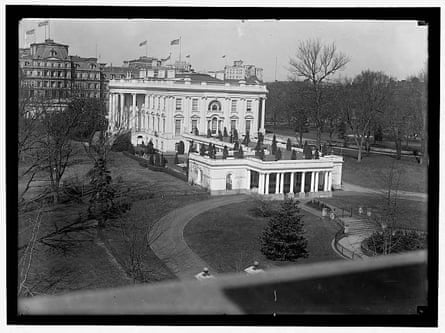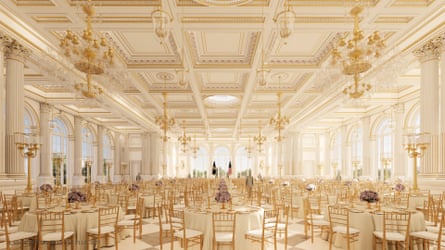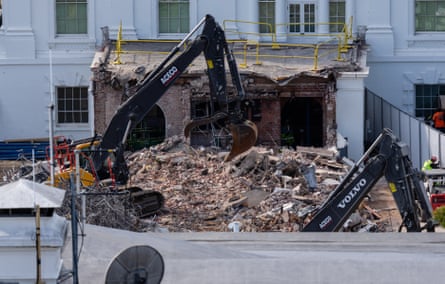It was confirmed on Friday that the East Wing of the White House has now been completely destroyed, days after construction started on the planned $300m (£225m) ballroom that Donald Trump is adding to the historic building.
The demolition marked a reversal of Trump’s earlier promise in July that none of the White House’s existing infrastructure would be torn down during construction of the ballroom.
The rapid pace of the project, coupled with images of rubble at the president’s residence has elicited a chorus of disgust among White House alumni and presidential historians, while the Trump administration has dismissed the criticism as “manufactured outrage”.
What is the East Wing?
The East Wing was first known as the East Terrace and was built during the presidency of Theodore Roosevelt in 1902. Franklin Roosevelt created the East Wing in its current form in 1942 to add working space during the war, but also to conceal an underground bunker that had been constructed for the president and staff.
Over time it became the home base for the first lady and her staff. It was also the home of the Jacqueline Kennedy Garden.

Sitting across East Executive Avenue from the Treasury Department, it represented the social side of the White House and was where tourists and other guests entered for events.
In the original plan for the ballroom, it would have remained untouched and, in Trump’s telling, become a space where guests would mingle, sip cocktails and eat hors d’oeuvres until they were called into the ballroom for dinner. However, days after ground was broken on the new project, the White House confirmed the entire wing would be torn down and that process appeared to be completed by Friday.
What can we expect from the new ballroom?
Trump has complained that the White House needs a large entertaining space and that the East Room is too small, with capacity for only about 200 people.
The 90,000-square-foot (27,400sqm) ballroom will dwarf the main White House, at nearly double the size, and Trump says it will accommodate 999 people.
Renderings released by the White House suggest a strong resemblance to the gilded ballroom at Mar-a-Lago, Trump’s private club and home in Palm Beach, Florida. The White House has said the ballroom will be ready for use well before Trump’s term ends in January 2029, an ambitious timeline.

The president has been adamant that the ballroom will not come at a cost to taxpayers, because it is being privately funded by “many generous Patriots, Great American Companies, and, yours truly”.
Donors for the proposed ballroom include a slew of major tech companies, including Apple, Amazon, Meta, Microsoft and Google. Defense contractors and communications companies have also pitched in, including Lockheed Martin, Palantir, T-Mobile and Comcast.
The president began construction despite the lack of signoff from the National Capital Planning Commission, the executive branch agency that has jurisdiction over construction and major renovations to government buildings in the region.
What has been the reaction to the bulldozing of the East Wing?
The image of broken masonry, rubble and steel wires at America’s most famous address appeared to strike a chord even with people who have become accustomed to shrugging off Trump’s outrageous antics.
David Frum, a former speechwriter for President George W Bush, tweeted: “Something profoundly symbolic about Trump taking a wrecking ball to the White House … paying for the demolition with money from cronies and insiders seeking government favors … and the Republicans in Congress acquiescing as Trump treats public assets as private property.”

The National Trust for Historic Preservation on Tuesday asked the Trump administration to pause the demolition until the planning commission review was completed. Its letter expressed concern that the proposed ballroom would “overwhelm the White House itself”.
Douglas Brinkley, a presidential historian, was quoted by WTOP News as saying: “Maybe it’s just the dislike of change on my part, but it seemed painful, almost like slashing a Rembrandt painting. Or defacing a Michelangelo sculpture.”
In an appearance on Fox News on Friday, Trump adviser Stephen Miller defended the unannounced demolition of the entire East Wing, arguing that the extension was not really part of the White House.
“It was a cheaply built add-on structure … [it] is badly in need of refurbishment, repair and renovation,” he said.
What have other presidents done to change the White House?
Presidents have added to the White House since construction began in 1792 for a host of reasons, and Trump aides say his decision to build a ballroom follows that long tradition.
Thomas Jefferson added the east and west colonnades.
Andrew Jackson built the North Portico on the Pennsylvania Avenue side of the White House, aligning with the South Portico that James Monroe added after the original mansion was rebuilt after the British burned it during the war of 1812.
Theodore Roosevelt added the West Wing to provide dedicated space for the president and senior staff, while Franklin D Roosevelt added the East Wing.
One of the most significant White House renovations happened under Harry Truman, when the mansion was found to be so structurally unsound that he ordered a complete gutting of the interior that lasted from 1948 to 1952. The project, including Truman’s addition of a balcony to the second floor of the South Portico, was highly controversial.
Other changes include the creation of the Rose Garden during John F Kennedy’s administration and Richard Nixon’s decision to convert an indoor swimming pool that was built for FDR’s physical therapy into a workspace for the growing White House press corps.
With Reuters and the Associated Press

 German (DE)
German (DE)  English (US)
English (US)  Spanish (ES)
Spanish (ES)  French (FR)
French (FR)  Hindi (IN)
Hindi (IN)  Italian (IT)
Italian (IT)  Russian (RU)
Russian (RU)  1 month ago
1 month ago
























Comments